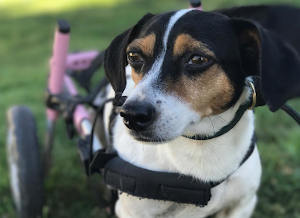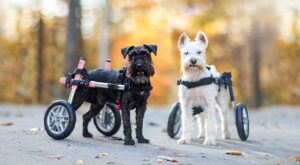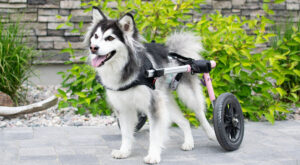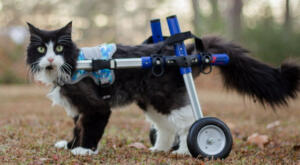Whether your dog is born deaf or gradually loses
their hearing overtime, there is no reason why they can’t live a normal, active
life. With a little training, and a few small adjustments in your life, you dog
can do anything.
What is Canine Deafness?
The term “deaf” can be used to describe many different types and levels of hearing loss. Deafness can refer to partial deafness or complete hearing loss. Your pet’s loss of hearing can be temporary or permanent depending on the cause. Just like a human, your dog can experience hearing loss in one or both ears. A bilaterally deaf dog is completely deaf and experience complete hearing loss in both ears. Whereas a unilaterally deaf dog is considered partially deaf (deaf in one ear) and has at least partial hearing in the other ear.
Hereditary Deafness in Dogs
The most common cause of deafness is genetics,
and there are several breeds that are more prone to hearing loss than others. A
common trait within these breeds is coat color. Dogs with white or merle coats
have a higher risk of being born with congenital deafness.
- Dalmatians – 30% of Dalmatians are born deaf in one or both ears
- English Setters
- Australian Shepherds – “lethal white” or double merle Australian Shepherds can be deaf, blind, or both
- Jack Russell Terriers
Common Causes of Canine Hearing Loss
- Ear wax buildup in the ear canal
- Untreated or chronic ear infections
- Injury
- Drug toxicity
- Tumors
- Congenital birth defects
- Gradual hearing loss due to aging
How to Tell if Your Dog is Deaf
Due to your dog’s incredible senses, they can easily compensate for their hearing loss by relying more heavily on their other senses. Dogs experience life with their sense of smell first, followed by sight, then hearing. This can make it even more challenging to detect hearing loss, especially if the loss occurs gradually.
Know what signs to look for if you think your dog is deaf:
- A change in dog obedience or response to common commands
- No longer responds when you call them
- Your pet doesn’t react to the sounds of squeaky toys, doorbells or other common noises
- They have a difficult time waking up
- Dog reacts aggressively when woken
- The are easily startled
- Excessive barking for no reason
- Shaking or tilting their head frequently
By far the most noticeable sign a dog is experiencing hearing loss is when your dog begins to ignore your directions. High pitched sounds, like a whistle, is often the first tones a deaf dog loses. Instead you deeper tones like a clap to get your dog’s attention or to call them.
Since puppies are less focused and find it harder to focus as a rule, it’s more difficult to tell if a puppy is deaf. A puppy with hearing problems tends to be easily frightened (especially by approaching footsteps). Along with skittish behavior, see if your puppy reacts to the sound of squeaker toys that they can’t see, and watch for signs of their ears moving towards the sound.
4 Ways to Help Your Deaf Dog
1. Visit the Veterinarian
If your dog is showing signs of hearing loss, make an
appointment to speak with your Vet. During the exam your Vet will check your
pet’s ear canal to make sure they’re clear of any buildup and that there is no
sign of infection. Your Vet will also do a simple hearing exam, such as
standing behind or to the side of your dog and clapping to check their
responsiveness.
Tip: If you try to test your dog’s hearing at home, step back a
bit. Your dog may not be able to hear, but they may be able to sense vibrations
if you stand too close!
Your Vet will most likely administer a BAER test or brain stem auditory evoked
response test. The BAER test is the definitive hearing test, which measures the
electrical activity in the brain.
2. Find New Ways to Communicate
Just like any other dog, a deaf dog wants to communicate and bond with their family. And it’s never too late to teach your dog new tricks! A pet that is hard of hearing or deaf can’t respond to verbal commands, switch to hand signals! Create different hand signals for each command, some people base the signals off of American Sign Language or create their own that’s easy to remember.
Tip: Make sure to create a unique hand signal to represent your dog’s name, so they know when to respond.
3. Switch to Visual Cues
Deaf dogs need to rely on hand signals and other visual cues from their owner to communicate. Touch is an important part of training a deaf dog or puppy. A dog experiencing hearing loss can be easily startled and often struggle with separation anxiety. Gently touch your deaf dog when you enter or leave a room so they’re always aware of where you are. A startled dog can easily act aggressively, make sure everyone in your family (especially children) know how to interact with your pet.
Tip: At night, you can turn lights on or off or use a flashlight to signal your dog.
4. Keep Your Pet Safe Outside
Pets with hearing loss may not hear busy traffic or be aware of other dangers around them, which can make bathroom trips scary and dangerous. Deaf pets should be kept on a leash at all times or in fenced in yard for their own safety.
Tip: If your dog is off leash, attach a bell or a light to their collar so you always know where they are.


Related Articles:
Did we answer all your questions on "Hearing Loss"?












[…] have to adopt a different approach – one that is suitable for his special needs. If your dog has a hearing impairment, is blind, or has a mobility disability, here are tips to help with obedience […]